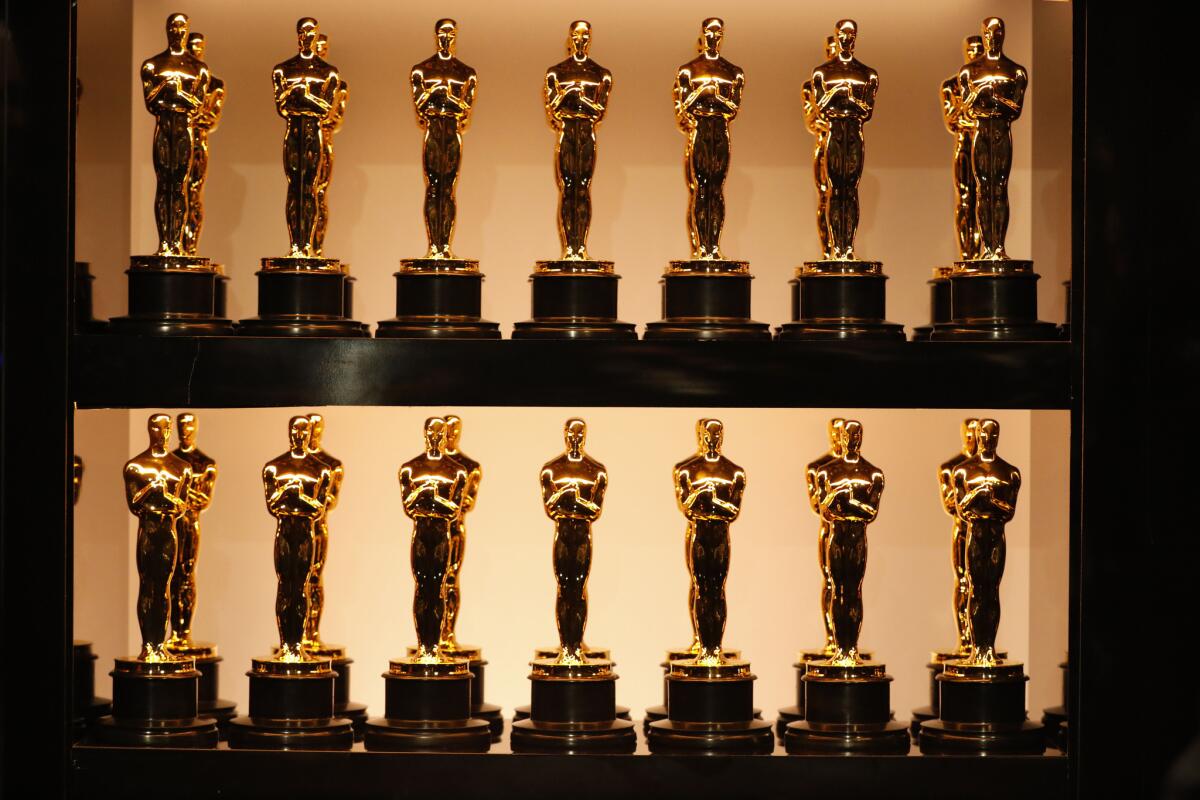New Oscars standards say best picture contenders must be inclusive to compete

- Share via
And the Oscar goes to ... inclusion.
In the latest step in its ongoing effort to boost diversity both within its own ranks and across the film industry, on Tuesday the film academy announced new representation standards for films to be eligible to compete for best picture.
Developed over the past few months by a special task force as part of the organization’s Academy Aperture 2025 initiative, the standards encompass both representation onscreen — in the types of stories being told and the actors involved — as well as behind the scenes in the makeup of the crew and in the inclusivity of the companies involved.
To be eligible for best picture, a film must meet at least two standards across four categories: “Onscreen Representation, Themes and Narratives,” “Creative Leadership and Project Team,” “Industry Access and Opportunities” and “Audience Development.” Within each category are a variety of criteria involving the inclusion of people in underrepresented groups, including women, people of color, LGBTQ+ people and those with cognitive or physical disabilities. (Other Oscar categories will not be held to these same standards, but the contenders for best picture typically filter down to other feature-length categories.)
Previously, the only standards to qualify for best picture involved a film’s running time (over 40 minutes) and specifics about how, where and when it’s screened in a public venue.
The new standards will not go into effect until the 96th Oscars in 2024. But at a time of racial reckoning both for Hollywood and the nation as a whole, the academy believes the requirements provide a road map for how the industry can ensure that at least those films that compete for its highest honor reflect the diversity of the moviegoing audience and the wider world.
“The aperture must widen to reflect our diverse global population in both the creation of motion pictures and in the audiences who connect with them,” Academy President David Rubin and Chief Executive Dawn Hudson said in a joint statement. “The Academy is committed to playing a vital role in helping make this a reality. We believe these inclusion standards will be a catalyst for long-lasting, essential change in our industry.”
The new standards were developed by a task force headed by academy governors DeVon Franklin and Jim Gianopulos, using a template inspired by the British Film Institute Diversity Standards that govern eligibility in some categories of the BAFTAs and in consultation with the Producers Guild of America.
Among the new standards, those concerning onscreen representation are likely to garner the most scrutiny. Indeed, some recent best picture nominees that featured almost exclusively white and male casts — including the World War I film “1917” and the gangster epic “The Irishman” — might have had difficulty meeting the new onscreen standards. Those standards require one of the following: at least one of the lead actors or significant supporting actors is from an underrepresented racial or ethnic group; at least 30% of all actors in secondary and more minor roles are from certain underrepresented groups; or the main storyline, theme or narrative is centered on an underrepresented group.
Mindful of the difficulty of enforcing potentially heavy-handed mandates on the types of stories that are deemed worthy for best picture consideration, however, the academy is building in the flexibility for films to meet the inclusion requirements in other areas. For example, films can meet the “Industry Access and Opportunities” standard if the studio or production company offers paid apprenticeship and internship opportunities and training programs for underrepresented groups across a range of fields, something that is quite common across the industry.
In recent years, the academy has announced a number of changes — including plans for a special category for “best popular film” and the paring of several awards categories from the Oscars telecast — only to roll them back after criticisms that they were ill-conceived and half-baked. But by announcing its new inclusion requirements more than three years before they will go into effect, the academy is giving the industry plenty of time to adapt. (For the 2022 and 2023 Oscars, potential best picture nominees will be required to submit a confidential Academy Inclusion Standards form but will not be held to particular inclusion thresholds.)
Announced in June, the Academy Aperture 2025 initiative marks the next chapter of the academy’s diversity efforts that began in response to two consecutive years of #OscarsSoWhite controversy. The initiative is geared toward further increasing representation in the organization’s governance, membership and workplace culture, as well as in the films nominated for Oscars. In June, the organization announced that it had surpassed the goal, set in early 2016, of doubling the number of women and people from underrepresented ethnic/racial communities in the group by 2020.
The full breakdown of the new standards is below:
For the 96th Oscars (2024), a film must meet TWO out of FOUR of the following standards to be deemed eligible:
STANDARD A: ON-SCREEN REPRESENTATION, THEMES AND NARRATIVES
To achieve Standard A, the film must meet ONE of the following criteria:
A1. Lead or significant supporting actors
At least one of the lead actors or significant supporting actors is from an underrepresented racial or ethnic group.
• Asian
• Hispanic/Latinx
• Black/African American
• Indigenous/Native American/Alaskan Native
• Middle Eastern/North African
• Native Hawaiian or other Pacific Islander
• Other underrepresented race or ethnicity
A2. General ensemble cast
At least 30% of all actors in secondary and more minor roles are from at least two of the following underrepresented groups:
• Women
• Racial or ethnic group
• LGBTQ+
• People with cognitive or physical disabilities, or who are deaf or hard of hearing
A3. Main storyline/subject matter
The main storyline(s), theme or narrative of the film is centered on an underrepresented group(s).
• Women
• Racial or ethnic group
• LGBTQ+
• People with cognitive or physical disabilities, or who are deaf or hard of hearing
STANDARD B: CREATIVE LEADERSHIP AND PROJECT TEAM
To achieve Standard B, the film must meet ONE of the criteria below:
B1. Creative leadership and department heads
At least two of the following creative leadership positions and department heads—Casting Director, Cinematographer, Composer, Costume Designer, Director, Editor, Hairstylist, Makeup Artist, Producer, Production Designer, Set Decorator, Sound, VFX Supervisor, Writer—are from the following underrepresented groups:
• Women
• Racial or ethnic group
• LGBTQ+
• People with cognitive or physical disabilities, or who are deaf or hard of hearing
At least one of those positions must belong to the following underrepresented racial or ethnic group:
• Asian
• Hispanic/Latinx
• Black/African American
• Indigenous/Native American/Alaskan Native
• Middle Eastern/North African
• Native Hawaiian or other Pacific Islander
• Other underrepresented race or ethnicity
B2. Other key roles
At least six other crew/team and technical positions (excluding Production Assistants) are from an underrepresented racial or ethnic group. These positions include but are not limited to First AD, Gaffer, Script Supervisor, etc.
B3. Overall crew composition
At least 30% of the film’s crew is from the following underrepresented groups:
• Women
• Racial or ethnic group
• LGBTQ+
• People with cognitive or physical disabilities, or who are deaf or hard of hearing
STANDARD C: INDUSTRY ACCESS AND OPPORTUNITIES
To achieve Standard C, the film must meet BOTH criteria below:
C1. Paid apprenticeship and internship opportunities
The film’s distribution or financing company has paid apprenticeships or internships that are from the following underrepresented groups and satisfy the criteria below:
• Women
• Racial or ethnic group
• LGBTQ+
• People with cognitive or physical disabilities, or who are deaf or hard of hearing
The major studios/distributors are required to have substantive, ongoing paid apprenticeships/internships inclusive of underrepresented groups (must also include racial or ethnic groups) in most of the following departments: production/development, physical production, post-production, music, VFX, acquisitions, business affairs, distribution, marketing and publicity.
The mini-major or independent studios/distributors must have a minimum of two apprentices/interns from the above underrepresented groups (at least one from an underrepresented racial or ethnic group) in at least one of the following departments: production/development, physical production, post-production, music, VFX, acquisitions, business affairs, distribution, marketing and publicity.
C2. Training opportunities and skills development (crew)
The film’s production, distribution and/or financing company offers training and/or work opportunities for below-the-line skill development to people from the following underrepresented groups:
• Women
• Racial or ethnic group
• LGBTQ+
• People with cognitive or physical disabilities, or who are deaf or hard of hearing
STANDARD D: AUDIENCE DEVELOPMENT
To achieve Standard D, the film must meet the criterion below:
D1. Representation in marketing, publicity, and distribution
The studio and/or film company has multiple in-house senior executives from among the following underrepresented groups (must include individuals from underrepresented racial or ethnic groups) on their marketing, publicity, and/or distribution teams.
• Women
• Racial or ethnic group:
· Asian
· Hispanic/Latinx
· Black/African American
· Indigenous/Native American/Alaskan Native
· Middle Eastern/North African
· Native Hawaiian or other Pacific Islander
· Other underrepresented race or ethnicity
• LGBTQ+
• People with cognitive or physical disabilities, or who are deaf or hard of hearing
More to Read
Only good movies
Get the Indie Focus newsletter, Mark Olsen's weekly guide to the world of cinema.
You may occasionally receive promotional content from the Los Angeles Times.











